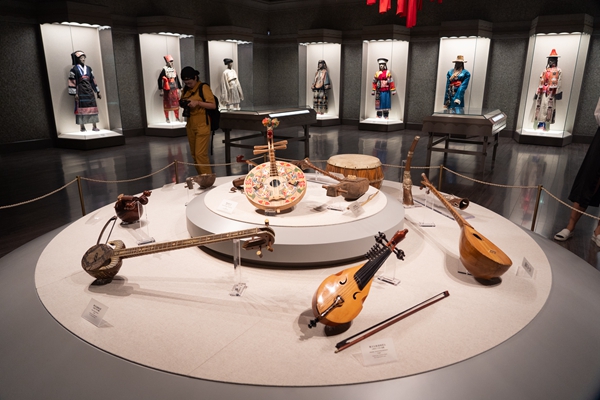
Traditional costumes and musical instruments used by 55 ethnic groups in China are also exhibited through March 22 (Photo: China Daily)
The gallery at Shanghai Museum featuring arts and crafts of ethnic minorities in China has been expanded as part of a relaunch.
Open through March 22, the gallery showcases traditional costumes, musical instruments and tools used by 55 ethnic groups in China. The gallery was founded in 1996 when objects from 41 ethnic groups were gathered for an exhibition.
"Thanks to our colleagues and working partners in different parts of China, we now have each of the ethnic minority groups represented in the exhibition," says Zhang Jingwei, curator of the exhibition and a researcher at Shanghai Museum.
Some of the objects, such as the national costumes of the Gelao, Mulam and Jing people were borrowed from the Anthropology Museum of Guangxi, while the handicrafts of the Tatar and Xibe people were loaned by the Museum of Xinjiang Uygur Autonomous Region.
Shanghai Museum began to actively collect the arts and crafts from China's ethnic minority groups as early as in the 1950s, starting with the Uygur ethnic group. Today, Zhang and his colleagues still make frequent trips to the faraway counties and communities of ethnic minority groups to buy from local artists and craftsmen their creations that include tapestry, embroidery and woven bamboo items.
"We have close ties with local cultural administrations, which recommend to us the recognized inheritors of intangible cultural heritage," Zhang tells China Daily.
"Unlike some expensive objects such as ancient bronze sculptures and ceramic pieces, these handicrafts often don't have high commercial value, and we can often afford to propose a reasonable price to the folk artists and craftsmen."
The inexpensive prices of folk art in China have also resulted in a growing number of private collectors, notes Zhang.
"They are able to build a collection of a particular category such as embroidered shoes, and embark on insightful research in their chosen field of cultural heritage. This is a good complement to the work of public museums and institutions," he says.
As visitors step into the gallery located on the fourth floor of the museum, they first come across a wooden dragon head-a part of a dragon boat from the Miao ethnic group in Southwest China's Guizhou province-hanging from the ceiling by the gate.
"Dragon boat racing is a traditional custom practiced in many parts of China, and this boat is special with a unique design of bull horns on it," Zhang says.
Below the dragon head is a double-decked platform where 12 musical instruments are showcased.
Also on exhibition are the dombra, a string instrument of the Kazak group, the morin khuur, also known as the horse-headed fiddle which is played by the Mongolian people, and a round drum from the Korean ethnic group in China.
In the chapter that features wood carving and sculptures, the museum has employed new special effects to provide an immersive experience for visitors. Shanghai Museum has also launched a H5 mini program together with website Eastday that enables mobile phone users to view aspects of the exhibition from their screens.
A series of documentary videos have also been produced to introduce the arts and handicrafts of China's minority ethnic groups. These videos have been released on social media platforms of Shanghai Museum.


